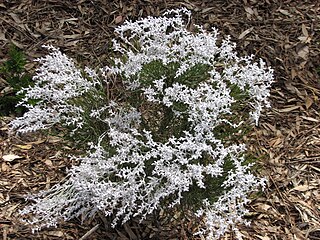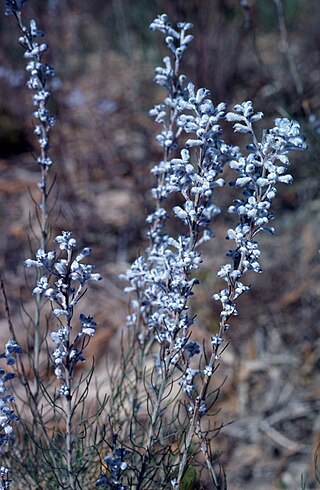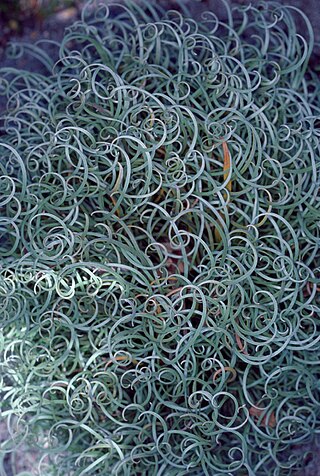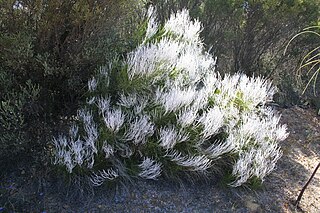
Conospermum acerosum, commonly known as needle-leaved smokebush, is a species of flowering plant in family Proteaceae and is endemic to the south west of Western Australia. It is spindly, erect or straggly shrub with needle-shaped or thread-like leaves, panicles of white or pink flowers and reddish brown nuts.

Conospermum glumaceum, commonly known as hooded smokebush, is a species of flowering plant in the family Proteaceae and is endemic to the south-west of Western Australia. It is an erect shrub with more or less clustered, linear leaves, and panicles of dense, head-like spikes of tube-shaped, cream-coloured flowers and white to golden nuts.

Conospermum stoechadis, commonly known as common smokebush, is a species of flowering plant in the family Proteaceae and is endemic to the south-west of Western Australia. It is an erect, compact shrub with thread-like leaves and spikes of woolly white, tube-shaped flowers.

Conospermum incurvum, commonly known as plume smokebush, is a species of flowering plant in the family Proteaceae and is endemic to the south-west of Western Australia. It is an erect, spindly or prostrate shrub with densely arranged cylindrical leaves, and panicles of white, tube-shaped flowers with dark blue bracteoles.

Conospermum brachyphyllum is a species of flowering plant in the family Proteaceae and is endemic to the south-west of Western Australia. It is an open shrub thread-like leaves, and panicles of woolly, white flowers.

Conospermum canaliculatum is a species of flowering plant in the family Proteaceae, and is endemic to the south-west of Western Australia. It is a dense, multistemmed, erect shrub with linear leaves and spike-like panicles of woolly white, tube-shaped flowers.

Conospermum capitatum is a species of flowering plant in the family Proteaceae, and is endemic to the south-west of Western Australia. It is a low, erect shrub with coiled leaves and head-like panicles of red to pale yellow and hairy, tube-shaped flowers.

Conospermum crassinervium, commonly known as summer smokebush or tassel smokebush, is a species of flowering plant in the family Proteaceae, and is endemic to the south-west of Western Australia. It is a low, tufted shrub with clustered leaves arranged at the base of the plant and corymbs of spikes of white to grey, hairy, tube-shaped flowers.

Conospermum densiflorum, commonly known as crown smokebush, is a species of flowering plant in the family Proteaceae and is endemic to the south-west of Western Australia. It is an erect, much-branched shrub with thread-like leaves at the base of the plant, and spikes or corymbs of velvety, cream-coloured or blue, tube-shaped flowers.

Conospermum filifolium is a species of flowering plant in the family Proteaceae and is endemic to the south-west of Western Australia. It is a shrub with thread-like, S-shaped leaves, and spike-like panicles of woolly white, occasionally blue, tube-shaped flowers.

Conospermum flexuosum, commonly known as the tangled smokebush, is a species of flowering plant in the family Proteaceae and is endemic to the south-west of Western Australia. It is a sprawling shrub with many zig-zag branches, panicles of white to pale blue, tube-shaped flowers and urn-shaped, hairy nuts.

Conospermum huegelii, commonly known as the slender smokebush, is a species of flowering plant endemic to the south-west of Western Australia. It is a low, clumped shrub with thread-like to narrowly cylindrical leaves, and spikes of pale blue to cream-coloured, tube-shaped flowers and hairy nuts.

Conospermum leianthum is a species of flowering plant in the family Proteaceae and is endemic to the south-west of Western Australia. It is a shrub with thread-like leaves, and panicles of white and more or less purple, tube-shaped flowers.
Conospermum microflorum is a species of flowering plant of the family Proteaceae and is endemic to Western Australia. It is a rounded shrub with glabrous, thread-like leaves, panicles of woolly hairy, white or cream coloured flowers and woolly hairy, orange-brown nuts.
Conospermum paniculatum is a species of flowering plant in the family Proteaceae and is endemic to the south-west of Western Australia. It is an erect, much-branched shrub with spoon shaped to egg-shaped leaves with the narrower end towards the base, and spikes of blue to pink, tube-shaped flowers, the fruit an urn-shaped nut.
Conospermum quadripetalum is a species of flowering plant in the family Proteaceae and is endemic to the south of Western Australia. It is a diffuse, straggly shrub with hooked leaves, circular in cross section, and panicles of blue, tube-shaped flowers with white and red hairs.

Conospermum spectabile is a species of flowering plant in the family Proteaceae and is endemic to the south-west of Western Australia. It is an erect, compact shrub with S-shaped leaves that are circular in cross section, and panicles of woolly white and blue, tube-shaped flowers.

Conospermum teretifolium, commonly known as the spider smokebush, is a species of flowering plant in the family Proteaceae and is endemic to the south of Western Australia. It is an erect shrub with leaves that are circular in cross section, panicles of creamy white, tube-shaped flowers and the fruit is a hairy nut.
Conospermum toddii, commonly known as Victoria Desert smokebush, is a species of flowering plant in the family Proteaceae and is endemic to inland areas of Western Australia. It is a spreading shrub with thread-like leaves, panicles of white, tube-shaped flowers and hairy nuts.

Conospermum triplinervium, commonly known as the tree smokebush or elk smokebush, is a species of flowering plant in the family Proteaceae and is endemic to the south-west of Western Australia. It is a shrub or tree with lance-shaped leaves, the narrower end towards the base, spike-like panicles of woolly, greyish white, tube-shaped flowers and hairy nuts.

















